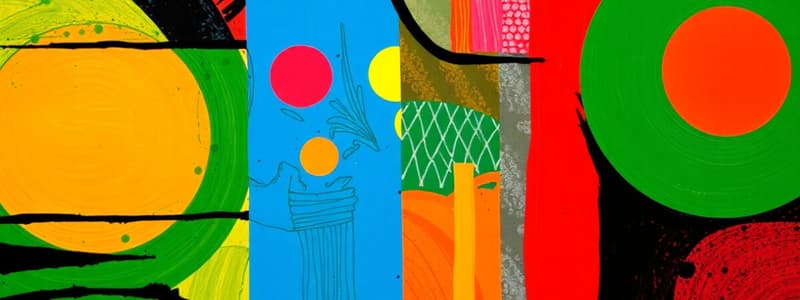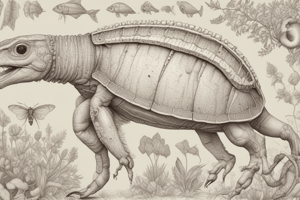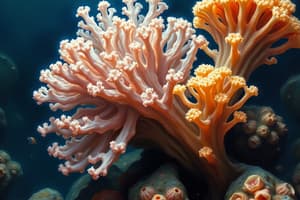Podcast
Questions and Answers
Which of the following is the most accurate statement regarding symmetry in eumetazoans?
Which of the following is the most accurate statement regarding symmetry in eumetazoans?
- All eumetazoans possess bilateral symmetry, reflecting their active, mobile lifestyles.
- Eumetazoans have either bilateral symmetry or radial symmetry derived from a bilateral ancestor. (correct)
- Eumetazoans primarily exhibit asymmetrical body plans due to their sessile nature.
- Eumetazoans exhibit only radial symmetry, a characteristic derived from their simple body plan.
Cnidarians and Ctenophora exhibit which level of organization?
Cnidarians and Ctenophora exhibit which level of organization?
- Organ level
- Organ system level
- Tissue level (correct)
- Cellular level
What is the function of cnidocytes in cnidarians?
What is the function of cnidocytes in cnidarians?
- Providing structural support through a hydrostatic skeleton
- Digesting prey intracellularly
- Capturing prey and defense (correct)
- Facilitating locomotion through muscular contractions
What is the primary purpose of the golgi apparatus in cnidocytes?
What is the primary purpose of the golgi apparatus in cnidocytes?
How do cnidarians replace discharged nematocysts?
How do cnidarians replace discharged nematocysts?
What role does the hydrostatic skeleton play in Anthozoans?
What role does the hydrostatic skeleton play in Anthozoans?
What materials are the axial skeletons of some cnidarians composed of?
What materials are the axial skeletons of some cnidarians composed of?
Which of the following describes the musculature found in cnidarians?
Which of the following describes the musculature found in cnidarians?
How is the nerve net structured in cnidarians?
How is the nerve net structured in cnidarians?
What is the role of nonpolar neurons in cnidarians?
What is the role of nonpolar neurons in cnidarians?
What is the function of statocysts in medusa forms of cnidarians?
What is the function of statocysts in medusa forms of cnidarians?
How do cnidarians typically digest their food?
How do cnidarians typically digest their food?
Which of the following is a characteristic feature of Class Hydrozoa?
Which of the following is a characteristic feature of Class Hydrozoa?
What is the function of nectophores in pelagic colonial hydrozoans?
What is the function of nectophores in pelagic colonial hydrozoans?
What is the function of the velum in the medusa form of some cnidarians?
What is the function of the velum in the medusa form of some cnidarians?
Which of the following is characteristic of the Class Scyphozoa?
Which of the following is characteristic of the Class Scyphozoa?
What is the function of rhopalia in scyphozoans?
What is the function of rhopalia in scyphozoans?
What is a key characteristic that distinguishes Anthozoans from other cnidarians?
What is a key characteristic that distinguishes Anthozoans from other cnidarians?
What is the function of siphonoglyphs in anthozoans?
What is the function of siphonoglyphs in anthozoans?
Which of the following is a characteristic feature of the Subclass Octocorallia?
Which of the following is a characteristic feature of the Subclass Octocorallia?
What are pinnules?
What are pinnules?
What role do zooanthellae play in coral reef ecosystems?
What role do zooanthellae play in coral reef ecosystems?
What is a common threat to coral reefs?
What is a common threat to coral reefs?
Which of the following best describes the ecological role of coral reefs?
Which of the following best describes the ecological role of coral reefs?
According to the cladogram, which class is most closely related to Hydrozoa?
According to the cladogram, which class is most closely related to Hydrozoa?
Based on information in the cladogram, which of the following classes is part of the Medusozoa?
Based on information in the cladogram, which of the following classes is part of the Medusozoa?
What is the characteristic tentacle number in organisms belonging to the subclass Octocorallia?
What is the characteristic tentacle number in organisms belonging to the subclass Octocorallia?
What specialized cells are unique to cnidarians, used for stinging?
What specialized cells are unique to cnidarians, used for stinging?
Which class of cnidarians is characterized by a dominant medusa stage and includes jellyfish?
Which class of cnidarians is characterized by a dominant medusa stage and includes jellyfish?
What is the role of mesoglea in cnidarians?
What is the role of mesoglea in cnidarians?
Which of the following is an example of a colonial Hydrozoan that uses pneumatophores for buoyancy?
Which of the following is an example of a colonial Hydrozoan that uses pneumatophores for buoyancy?
Where does extracellular digestion occur in cnidarians?
Where does extracellular digestion occur in cnidarians?
What is the term for the asexual process where a polyp divides transversely to form juvenile medusae?
What is the term for the asexual process where a polyp divides transversely to form juvenile medusae?
Organisms in the Class Anthozoa may possess structures called acontia and acrorhagi. What is their primary function?
Organisms in the Class Anthozoa may possess structures called acontia and acrorhagi. What is their primary function?
Flashcards
Hexactinellida
Hexactinellida
A class of sponges known as the "glass sponges"
Demospongiae
Demospongiae
Sponges with siliceous spicules that are NOT six-rayed, or spongin, or both.
Calcarea
Calcarea
Sponges with spicules of calcium carbonate, needle-shaped or three- or four-rayed.
Cnidaria
Cnidaria
Signup and view all the flashcards
Medusozoa
Medusozoa
Signup and view all the flashcards
Hydrozoa
Hydrozoa
Signup and view all the flashcards
Scyphozoa
Scyphozoa
Signup and view all the flashcards
Statocysts (in jellyfish)
Statocysts (in jellyfish)
Signup and view all the flashcards
Strobilation
Strobilation
Signup and view all the flashcards
Anthozoa
Anthozoa
Signup and view all the flashcards
Octocorallia (Alcyonaria)
Octocorallia (Alcyonaria)
Signup and view all the flashcards
Pinnules
Pinnules
Signup and view all the flashcards
Hexacorallia (Zoantharia)
Hexacorallia (Zoantharia)
Signup and view all the flashcards
Zoantharian Corals
Zoantharian Corals
Signup and view all the flashcards
Hydrostatic skeleton
Hydrostatic skeleton
Signup and view all the flashcards
Gastrodermis
Gastrodermis
Signup and view all the flashcards
Coronal Muscles
Coronal Muscles
Signup and view all the flashcards
Nerve Net
Nerve Net
Signup and view all the flashcards
Cnidocytes
Cnidocytes
Signup and view all the flashcards
Cnidae
Cnidae
Signup and view all the flashcards
Nematocyst
Nematocyst
Signup and view all the flashcards
Spirocyst
Spirocyst
Signup and view all the flashcards
Ptychocyst
Ptychocyst
Signup and view all the flashcards
Siphonoglyph
Siphonoglyph
Signup and view all the flashcards
Hydropolyp
Hydropolyp
Signup and view all the flashcards
Nectophores
Nectophores
Signup and view all the flashcards
Bracts/Phyllozooids
Bracts/Phyllozooids
Signup and view all the flashcards
Pneumatophores
Pneumatophores
Signup and view all the flashcards
Cormidia
Cormidia
Signup and view all the flashcards
Hermatypic corals
Hermatypic corals
Signup and view all the flashcards
Diploblastic
Diploblastic
Signup and view all the flashcards
Metamerism
Metamerism
Signup and view all the flashcards
Medusa
Medusa
Signup and view all the flashcards
Medusa Anatomy
Medusa Anatomy
Signup and view all the flashcards
Class Hydrozoa
Class Hydrozoa
Signup and view all the flashcards
Study Notes
Porifera (Sponges)
- Characterized as sponges
- Sponges do not have advanced organization beyond the cellular level
Demospongiae
- Includes Heteroscleromorpha which contains 5341 species
- Includes Haploscleromorpha which contains 1084 species
- Includes Myxospongiae which contains 138 species
- Contains bath sponges, including the Keratosa, which have 558 species
Hexactinellida
- Includes glass sponges
- The Hexasterophora contain 513 species
- The Amphidiscophora contain 177 species
Homoscleromorpha
- Consists of flesh sponges
- The Oscarellidae contain 19 species
- The Plakinidae contain 68 species
Calcarea
- Includes calcareous sponges
- The Calcinea contain 167 species
- The Calcaronea contain 514 species
Placozoa
- Contains only one species
Ctenophora
- Contains 192 species of comb jellies
Cnidaria
- Radiate animals
- Cnidaria and Ctenophora make up the radiate animals
- Cnidaria and Ctenophora have not advanced beyond tissue-level organization
- Other eumetazoans have bilateral symmetry, or their radial symmetry is derived from a bilateral ancestor
- Exhibit two well-defined germ layers, the ectoderm and endoderm.
- Mesoderm is derived from ectoderm
- Possess an internal body cavity, the gastrovascular cavity
- Extracellular digestion occurs in the gastrovascular cavity
- Gastrodermal cells accomplish cellular digestion
- Most have tentacles for food capture
- Simplest animals with nerve cells, but no central nervous system
- Use sense organs like statocysts and ocelli
- Locomotion achieved by muscular contraction or ciliary comb plates
- Come in polyp and medusa forms, allowing for wider ecological possibilities
- Unique features are cnidocytes (nematocysts), colloblasts, and ciliary comb plates
- The simplest animals, radiates possess statocysts and ocelli as their sense organs
- Muscular contraction or ciliary comb plates provide locomotion
- Both polyp and medusa forms allow wider ecological possibilities
- Cnidocytes (nematocysts), colloblasts, and ciliary comb plates are key features
- A variety of support mechanisms are exhibited, these include: hydrostatic skeletons, mesoglea, axial skeletons and calcareous skeletons
- Exhibit the most primitive type of musculature
- Modified epidermal (epitheliomuscular) and gastrodermal (nutritive muscle) cells are a part of musculature
- Sessile polyp movements are limited to extending, contracting, or bending
- Well-developed pedal disc muscles (as seen in sea anemones)
- Medusae are dominated by epidermal muscles
- Coronal muscles (circular sheets of epidermis) are around the bell margin and over subumbrellar surface
- Nervous system has neurosensory cells (neurons) arranged as a nerve net
- Nonpolar neurons can send impulses in all directions, reducing intensity distally
- Medusa forms have an epidermal nerve net near the bell margin
- Nerves control both the tentacles and sense organs, and the bell pulsations
- Have two categories of neurons: ganglion (intermediary neural connections) and sensory cells (receive stimuli)
- Sensory structures are relatively few in polyps
- Minute hair-like projections are distributed across the general body surface (mechanoreceptors & chemoreceptors) for tentacle and general body movement
- Medusae forms have more varied structures
- Ocelli are pits of photoreceptor cells
- Statocysts are pits of vesicles containing statoliths that orients the organism to direction of gravitational pull
- Generally carnivorous
- Food is taken to the mouth and digested extracellularly
- Secretions from mucous gland cells and enzymatic gland cells digest food extracellularly
- Complete digestion occurs in the nutritive cells within the food vacuoles
- Cnidocytes have stinging cells produced by cnidoblasts
- Cnidocytes have a thread released upon stimulation of cnidocil (mechanoreceptor)
- Cnidocytes function is for food collection, defense, locomotion, and attachment
- Nematocysts are harpoon-like tubes connected to toxin sacs that paralyze victims
- Spirocysts are sticky tubes or loops that wrap around and stick to the victim
- Ptychocysts are sticky long threads; found only in burrowing anemones
- Discharged Cnidocytes are replaced by interstitial cells within 48 hours
Medusozoa
- A clade within the phylum Cnidaria that includes the classes Scyphozoa, Cubozoa, and Hydrozoa
Hydrozoa
- Includes 3395 species of Hydroidolina
- Includes 157 species of Trachylina
- Cnidarians that have colonial species and freshwater representatives
- Possess varied forms of nematocysts (approx. 30), including venomous types (=penetrants)
- Exhibits two body forms: polyp (hydropolyp) and medusa
- Polyp (hydropolyp) - possess a pedicel (stalk) and a hydranth (flower)
- Hydra are solitary hydropolyp
- Colonial forms (sessile, benthic species = hydroids)
- Pelagic species are siphonophores
- Polyp (hydropolyp) - possess a pedicel (stalk) and a hydranth (flower)
- Hydroid colonial forms have the following zooids:
- Stolonate – zooids with a tubular body arising from stolons
- Coenosarc – zooids arise from a single continuous tissue, joined inside by solenia
- Fruticose - zooids with bushy, feathery arrangement
- Pelagic colonial species (Siphonophores)
- Polymorphic colonies that form trailing clusters called cormidia
- Modified medusae may have nectophores(jet propulsion) or leaflike defensive modules called bracts or phyllozooids
- Possess floating pneumatophores used for buoyancy
- Polymorphic colonies include: gastrozooids (feeding zooid), gonozoids (holds medusa buds), and dactylozooids (food-catching zooids)
- Medusae are bell-shaped with an exumbrella and subumbrella
- Subumbrellar margin has velum (creates water jet)
- Mouth has a manubrium, dilates as a stomach, and extends as four radial canals
- Statocyst or ocelli are present on bell margin
- Mesoglea lacks cells
Scyphozoa
- Exhibit a medusa form
- Tetramerous symmetry is shown with a manubrium that divides into four oral arms
- Septa divides the gastrovascular cavity into four gastric pouches
- Margins of septa bear gastric filaments extending freely into the stomach
- Umbrella margin has scalloped into rounded lobes (=lappets) with sensory lobes called rhopalia placed between lappets
- Mesoglea contains amebocytes
- Asexual reproduction involves a polyp form that divides transversely (strobilation) to form a juvenile medusa, known as the ephyra
Anthozoa
- Anthozoa comprises 70% of all Cnidarian species
- All are marine and lack a medusa form
- Development on the polyp structure focuses on increasing the surface area of the gastrovascular cavity
- Mouth connects to a tubular pharynx and siphonoglyphs
- Gastrovascular cavity is partitioned by mesenteries or septas
- Incomplete mesenteries of the gastrovascular cavity are trilobed, ciliated, and equipped with nematocysts
- Other species are equipped with acontia and acrorhagi used for food capture, offense, and defense
- Subclass Octocorallia
- Possess 8 tentacles and 8 primary septa and a single siphonoglyph
- Tentacles are pinnate having lateral outfoldings called pinnules
- Includes Gorgonacea, Alcyonacea, Telastacea, Stolonifera, Coenothecalia and Pennatulacea
- Subclass Hexacorallia (Zoantharia):
- Sea anemone and true (stony) corals
- Unique feature: 6 pairs of primary mesenteries plus multiples of 6 tentacles
- Scleractinian corals (Order Scleractinia) are reef-building which secrete a calcium carbonate exoskeleton
- Sea Anemones
- Attach to shells, rocks, and timber etc with pedal discs and some burrow in mud or sand
- The flat oral disc has a crown of tentacles
- The slit-shaped mouth leads into a pharynx
- The siphonoglyph is a ciliated groove that creates the water current into the pharynx
- Currents bring carry oxygen and remove wastes to maintain fluid pressure for a hydrostatic skeleton
- In danger, water is rapidly expelled through pores as the contracted anemone shrinks
- Zoantharian Corals
- Scleractinia are also known as true or stony corals and are miniature sea anemones.
- Secrete a limey skeletal cup with sclerosepta to project into the polyp rather than a pedal disc
- The surfaces form a sheet of living tissue that connects all gastrovascular cavities
Studying That Suits You
Use AI to generate personalized quizzes and flashcards to suit your learning preferences.





